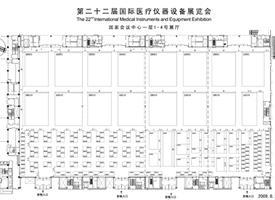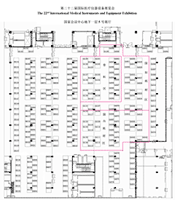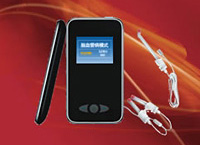New Exhibition Hall Introduction
Co-organized by Health Department of General Logistics Department of Chinese People's Liberation Army, China World Trade Center Co., Ltd., Huitong Xingye International Exhibition (Beijing) Co., Ltd., and Messe Düsseldorf China Ltd., the 22nd International Medical Instruments and Equipment Exhibition (CHINA MED 2010) is scheduled to be held at China National Convention Center on March 26 to 28, 2010.

Situated within the central zone of Beijing Olympic Park, China National Convention Center is adjacent to the National Stadium (commonly known as "Bird's Nest"), National Indoor Stadium, and National Aquatics Center (generally known as "Water Cube").
China National Convention Center is outfitted with state-of-the-art audio-visual equipment that suits a wide variety of multifunction service needs, such as conferences, banquets, performances, new product launches, and corporate activities. Within a 1 km radius around China National Convention Center ,there are three 5-star, seven 4-star and around ten 3-star hotels and apartments, which offer up to 5,000 rooms to fully meet the accommodation needs of large international conferences.
Conveniently situated on the North 4th Ring Road at the core of the Asian-Olympic Business Circle, the exhibition venue is at a distance of 26 km or 30 minutes' drive from Beijing Capital International Airport. The branch metro line for Olympiad that connects the urban core, railway station and airport stretches to the China National Convention Center station, which also accessible through a number of bus routes.
China National Convention Center will be open to public in November 2009. As the China's largest and newest convention center that is conveniently situated and well-serviced, the center is expected to stand out as a large exhibition center that can accommodate large conferences, exhibitions, and various public activities, and offer sufficient hotel rooms for such events.
Floor plan
 |
 |
Seminar Experts Introduction
 Yu Mengsun
Yu Mengsun
An academician of Chinese Academy of Engineering, Professor Yu also serves as the director of Aviation Medicine Engineering Research Center of Air Force Aviation Medicine Research Institute, a professor and doctorial tutor of the Fourth Military Medical University. In 1970, Professor Yu created the world's first dynamic response model of human spine under impulsive load, which has advanced lifesaving technology in the rocket ejection area. Professor Yu also led the research of 19 physiological, physical telemetry and magnetic recording systems in three categories. As a fruit of the research, he helped build a Chinese "Flight Lab" that has bolstered the development of China's aviation medicine. In the 1980s, Professor Yu championed a ground-free bioelectricity measurement technique and developed a range of high anti-interference electrophysiological apparatuses. In recent years, he has led a project team to invent a measurement technique relating to sleep structure and breathe event under natural sleep. Through teamwork, he has unlocked this long-time puzzle. Furthermore, this technique has begun to be used in related products. Professor Yu has won a string of awards, including the first and second prizes under the National Science and Technology Award, the third and fourth National Invention prizes, the first and second prizes under the Military Science and Technology Progress Award, and the second prize under the Beijing Science and Technology Progress Award.
 Xu Jiaxing
Xu Jiaxing
Graduated from Medical Collage of Shanghai Saint John's University in 1951, Mr. Xu received a doctor's degree in medicine. Doctor Xu was the former director of Radioactive Department (CT, magnetic resonance) in Air Force General Hospital, vice chairman of Chinese Radiological Association, chief editor of Chinese Journal of Radiation, and the member of Radiological Society of North America. Furthermore, he has attended a number of foreign academic conferences and kept abreast with latest technical developments in various imaging areas and their clinical applications in domestic and overseas.
 Wang Yan
Wang Yan
A professor and doctoral tutor, Professor Wang also serves as the director and chief physician of Orthopedics Department of PLA General Hospital. Currently, Professor Wang serves as the chief-elect of Orthopedics Branch of Chinese Medical Association, the chairman of Professional Orthopedics Committee of Chinese PLA, the president of Asia-Pacific Arthroplasty Society, a vice-chairman and general secretary of Chinese Orthopedics Physician Association, the secretary of International Ethnic-Chinese Orthopedics Association, a vice chairman of Journal of Spinal Surgery, and the deputy chief editor of Chinese Journal of Surgery. Additionally, Professor Wang is designated as a visiting associate professor of the Medical Collage of Stanford University, and a visiting professor of the Massachusetts General Hospital of Harvard Medical School. As a member of the Central Healthcare Team, Professor Wang has successfully completed a range of healthcare and operation tasks for top-ranking Party and government leaders. In 2008, Hu Jintao, the chairman of the Central Military Commission of the Communist Party of China conferred a first-class merit upon Professor Wang.
 Cai Kui
Cai Kui
Doctor Cai now serves as the director and deputy chief physician in the Department of Medical Engineering of Beijing Hospital. Graduated from Norman Bethune University of Medical Sciences in 1985, he received a doctor's degree in Medicine from the Medical Collage of University of Freiburg in 2003. From 1987 to 1991, he studied neural imaging diagnose in Tiantan Hospital. From 1993 to 2003, Doctor Cai worked in the Department of Magnetic Resonance in Beijing Hospital. He also studied in the U.S. between 1991 and 1992 and in 2000. During the 1997-1998 and 2001-2003 periods, he researched magnetic resonance in Germany. As one of the first Chinese doctors who specialized in diagnose through magnetic resonance, he is currently an expert with the consultation panel of the Central Healthcare Team, a proofreader of Chinese Journal of Radiation, and a standing member of the editorial board of Chinese Journal of Medical Equipment.
 Tian Jiahe
Tian Jiahe
Be a professor and doctoral tutor, Tian Jiahe serves as the director and chief physician of the Nuclear Medicine Department of PLA General Hospital. Professor Tian currently serves as the chairman of Nuclear Medicine Branch of Chinese Medical Association, the chairman of Nuclear Medicine Committee of PLA, the chief editor of Chinese Journal of Nuclear Medicine. Concurrently, he works for the U.S. journal J Nucl Med, and the British journal Nucl Med Commu. Since 1993, Professor Tian has remained entitled to special government allowances from the State Council.
 Xia Tingyi
Xia Tingyi
A doctor and chief physician of Japanese medicine, an expert at PLA Air Force, and a doctoral tutor of the Third Military Medical University, Doctor Xia serves in the capacity of director of Department of Radiation Oncology of Air Force General Hospital, the director of Gamma Knife Center (for head and body), the director of Radiation Oncology Center of PLA. Concurrently, he also serves as a standing member and secretary of Radiation Oncology Committee of Chinese Medical Association, vice chairman of Oncology Target Technique and Treatment Branch of Chinese Society of Biomedical Engineering, a member of Chinese Radiation Oncology Committee, chairman of Radiation Oncology Committee of Beijing Medical Doctor Association, vice chairman of Radiation Oncology Committee of PLA, a member of Oncology Committee of PLA, chairman of Oncology Committee of Air Force, and a standing member of the editorial board of Chinese Journal of Radiation Oncology.
 Tian Zengmin
Tian Zengmin
A holder of master's degree, a professor and doctoral tutor, Professor Tian serves as the director and chief physician of Neurosurgery Department in Navy General Hospital. Currently, he serves in the capacity of the executive director of International Stereotactic and Functional Neurosurgery Association, vice chairman of the Functional Neurosurgery Team of Neurosurgery Branch of Chinese Medical Association, vice chairman of Trauma Committee of PLA, vice chairman of Beijing Neurosurgery Association, chairman of Medicine Branch of Beijing Medical Foundation, a deputy chief editor of Chinese Journal of Minimally Invasive Neurosurgery, and the chief editor of Foreign Journal of Cerebrovascular Disease.
Exhibitors' Newest Trends
CareStream Wireless Box Probe DRX-1 Is in Robust Demand
A recent report of CareStream Health (formerly "Kodak Health Group") revealed that the industry's first wireless box digital radiography (RD) probe it has launched enjoys huge market potential. CareStream showcased the product at the annual meeting of the registration office of the American College of Radiology (ACR).
"Combined with the convenience and imaging quality of DR products and with support for quick and simple installation, the DRX-1 system provides compelling appeal. The system enables us to build DR capabilities into our four busiest X-ray radiology/fluorescent test rooms and conventional X-ray imaging room without the hassle of replacing the old X-ray equipment," said Michael Jenoriki, the sales manager of the Atlantic City Imaging Center, New Jersey.
With a separate wireless box-sized DR probe, the DRX-1 system provides the ability to swiftly and cost-effectively evolve from X-ray radiography to computerized X-ray imaging. Without replacing the existing equipment, one system alone allows a hospital to conduct a number of inspections. In addition, system installation costs a little.
Integrated Medical Photonic Rhinitis Therapeutic Apparatus Makes a Debut

Rhinitis has long plagued the medical circle; however, as photonic technology advances, the chronic disease is more likely to be eradicated.
Based on strong expertise, the integrated medical photonic rhinitis therapeutic apparatus represents fruits of the technological advance. As an important channel of exchange between the human body and the outside world, a clear nose helps vitalize body and mind. Using light within a special wave band to irradiate the vascular net in the nasal cavity, the apparatus can reduce blood fat and prevent cerebral infarction and cardio-cerebral vascular diseases.
Fundamentals of the Therapy
1. Reducing blood density, improving blood rheology as well as blood oxygen level and microcirculation in body cells, enhancing erythrodegeneration, increasing the amount of oxygen, and improving regional blood circulation;
2.Vitalizing lysozyme and strengthening oxidation-reduction reaction and metabolic turnover to improve energy metabolism in the nasal cavity and facilitate nasal functions; reducing the percentage of middle molecules and removing excessive free radicals from inside the body to improve the immunity and sterilization of the mucous membrane and build up the nasal cavity's resistance against diseases;
3. Narrowing the mucous membrane's wound surface swiftly and enhancing its resistance against allergic sources;
4. Accelerating and improving tissue cilia's expulsion of toxin through normal oscillation, building up nasal power and cleaning the nasal cavity.
For more information about the therapy, please visit www.eti.com.cn
Yuyue's Large Molecular Sieve Oxygen Generator Is Registered
Yuyue has developed a large-sized molecular sieve oxygen generator, which is not registered, marking a new milestone for the company in the oxygen generator area.
According to Mao Jianqiang, the company's deputy general manager for oxygen generation systems, oxygen generation series has formed a leading part of Yuyue's product lineup. Hospitals use molecular sieves for centralized oxygen supply. As well as improving the safety of oxygen supply, the new approach has generated considerable profits. Currently, molecular sieve oxygen generators are widely used in medical agencies and are beginning to become a norm. The registration has significantly reinforced Yuyue's lineup of oxygen generation systems, giving a strong momentum to the growth of the company's oxygen generator series.
Currently, Yuyue's oxygen generator plant is stepping up construction as part of its move to launch products as early as possible.
As a long-term exhibitor that has attended 8 editions of CHINA MED, Yuyue is expected to showcase its X-ray apparatuses and central oxygen supply systems. The company has secured a run of contracts for its X-ray apparatus series in government bids. Yuyue's large molecular sieve oxygen generator is set to achieve greater market success.
GE Partners with Intel to Develop Household Medical Equipment
Given a surge in chronically ill patients and aging population, the demand for home care is growing. Recently, the U.S.-based company GE and Intel jointly announced an alliance in the area of household medical technology. Under a commercial deal, the two companies are expected to invest US$250 million in remote medical technology and market. GE's medical department will sell Intel's personal monitors, which Intel refers to as "Intel Health Guide" in the U.S. The product can collect patents' health information and remind them to take medicine and do other things as planned. Through the system, patients are able to have a video chat with their doctors to receive medical attendance or have a health check even at home.
According to the two companies' chiefs responsible for the deal, their alliance will complement each other's technical advantages as part of their commitment to developing a new generation of home care technologies, such as preventing patients from falls, reminding patients to take medicine in time, attending patients who suffer cardiovascular diseases, diabetes or sleep apnea, and monitoring people's health conditions.
BLU-MED Portable Hospital for China Earthquake Relief
 Last summer, AmeriCares delivered two field hospitals to China’s devastated Sichuan region, where health concerns remain acute following last year’s deadly 7.8-magnitude earthquake. The portable, durable 15-bed field hospitals serve as interim Rural Health Centers in the Sichuan Basin where the earthquake caused thousands to lose their lives and hundreds of thousands injured.
Last summer, AmeriCares delivered two field hospitals to China’s devastated Sichuan region, where health concerns remain acute following last year’s deadly 7.8-magnitude earthquake. The portable, durable 15-bed field hospitals serve as interim Rural Health Centers in the Sichuan Basin where the earthquake caused thousands to lose their lives and hundreds of thousands injured.
Designed to function in disaster conditions, the hospitals consist of adjoining climate-controlled, durable fabric structures, which will stand up to harsh weather and provide a clean, safe environment for patient care. Each hospital includes separate rooms for an operating theater, emergency treatment, a gynecology/labor ward, a laboratory, a radiology unit and a 15-bed patient ward. AmeriCares also financed the purchase of patient beds, exam tables, stretchers, wheelchairs, X-ray equipment, surgical supplies and other items necessary to completely equip the hospital.
The first hospital averages between 180-200 patients daily since opening in June 2008; in the first 30 days alone, 30 babies were born. The second hospital opened in July 2008 and provides outpatient services to the community of 20,000, serving between 40 – 50 patients each day. Some of the more common illnesses the medical staff treats are respiratory conditions, digestion and high blood pressure. In addition to the two field hospitals, AmeriCares purchased ambulances for both hospitals.
This latest initiative is part of a comprehensive, ongoing effort by AmeriCares to provide relief to earthquake survivors. In November 2005, AmeriCares provided a BLU-MED field hospital for disaster relief near Muzaffarabad, the Kashmir capital and epicenter of the 2005 Pakistan earthquake. AmeriCares continues to provide medicines and medical supplies as needed in the following months, treating thousands of patients in that BLU-MED hospital.
About BLU-MED Response Systems
BLU-MED Response Systems provides turn-key, portable shelter-based solutions for disaster medical surge facilities, alternate command centers, temporary housing and base camp requirements. The company offers a full range of medical equipment packages and configuration options. BLU-MED support services include vendor managed inventory options, field deployment, and training & exercise services.
BLU-MED facilities can be sized and customized to meet a variety of state and local emergency management and public health response requirements. Modular options include medical surge wards, patient treatment, decontamination, immunization/drug distribution, negative pressure isolation, and field laboratory units. BLU-MED Response Systems is a division of Alaska Structures, Inc. For more information see www.blu-med.com
Exhibiting Progress
Preparations for CHINA MED 2010 Are Well Underway
Preparations for CHINA MED 2010 are now in full swing. Renowned companies from domestic and overseas have signed for the exhibition. The big names include Philips, GE, Siemens, Toshiba, Huilong, and Weili.
The organizing committee welcomes more exhibitors' participation.
For international exhibitors, please contact us at 86 10 65051018/65054124/65924681 or 86 10 58203808/86 21 50278128; for domestic exhibitors, please contact us at 86 10 68181107 (medical equipment) or 86 10 68270463 (medical consumables). For more information about CHINA MED, please visit www.chinamed.net.cn/en.
Visitors Invitation
We have launched the promotion activities for trade visitors. Our staff in call center will invite previous exhibition visitors and potential visitors to create a rare opportunity for trade visitors to communicate with medical equipment suppliers.
For enquiries, please call 86 10 65050204/68227511.

